Used by manufacturers for quality control, museums to digitize their collections, medical professionals to create customized orthotics, and law enforcement to analyze the scene of a crime, professional-level 3D scanners offer more power and precision than ever before in smaller and more affordable packages.
3D scanners are now used in almost every industry, replacing human-eye-only inspection and labor-intensive manual measuring methods.
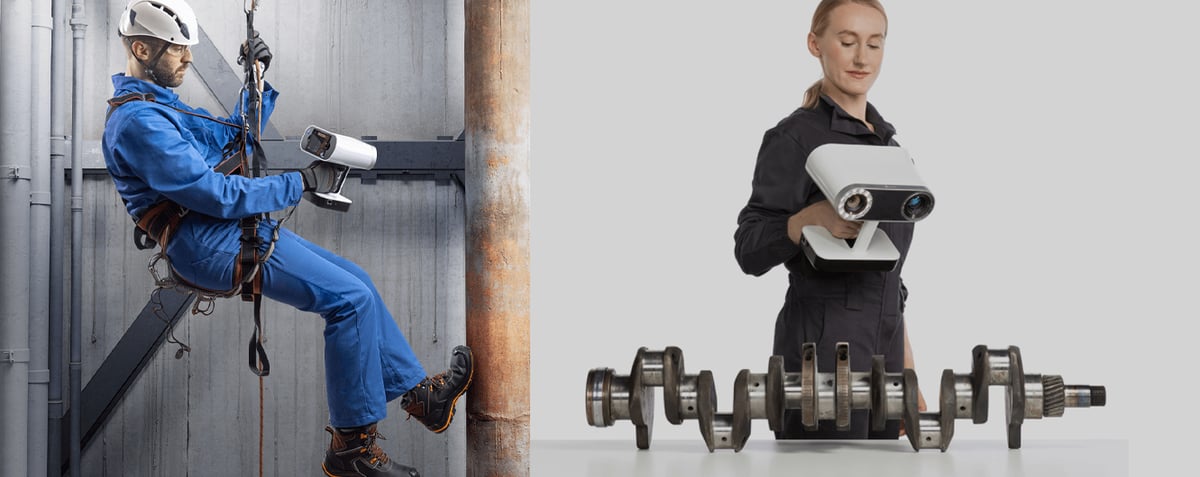
The ones on our list are designed for use in a work environment and have solid accuracy combined with automated workflows and powerful software, saving any business time and effort. Not every scanner does every job well so ask yourself if you’re interested in scanning scanning people and objects, or using your scanner in the field for quality control, reverse engineering, and inspection.
If you’re relatively new to 3D scanning, we’ve included a section below on the various technologies and what to look for in a scanner purchase, and if you’re budget is lower, see our top picks for budget scanners, many of which can also be handheld.
Of course, the hardware is only half the solution to effective 3D scanning, the software is where it magic really happens. The scanning solutions below should all export point clouds that you can then import into the software solution of your choice, but some have built-in software solutions that do a lot of the work for you. Read more about the critical role of software in the guide linked below.
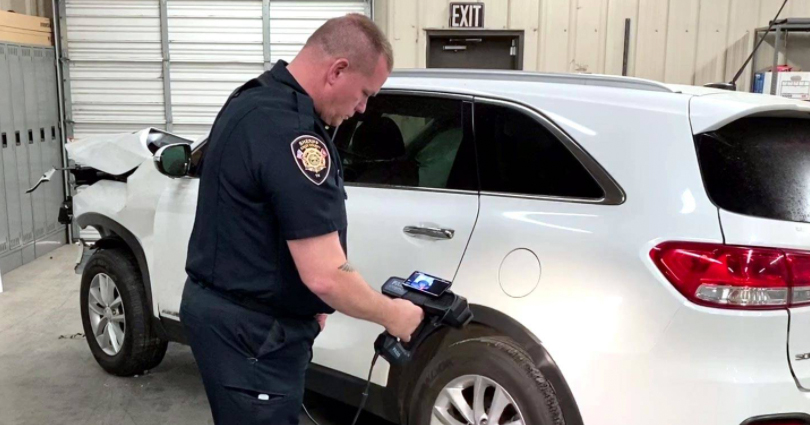
| Product | Accuracy | Technology | Working Distance | Market Price |
|---|---|---|---|---|
| Peel 3D Peel 3 | up to 0.1 mm | Structured Light | 250 to 550 mm | $8,500 |
| Polyga H3 | up to 0.08 mm | Structured Light | up to 470 mm | $11,000 |
| FARO Freestyle 2 | up to 0.5 mm | Laser Triangulation | 400 to 5,000 mm | $12,000 |
| Shining 3D EinScan HX | up to 0.04 mm | Structured Light & Laser Triangulation | up to 470 mm | $14,000 |
| Artec Eva | up to 0.1 mm | Structured Light | 400 to 1,000 mm | $15,600 |
| Creaform HandyScan 307 Silver Series | up to 0.03 mm | Laser Triangulation | 200 to 300 mm | $18,500 |
| Artec Space Spider | up to 0.05 mm | Structured Light | 350 to 1,200 mm | $23,800 |
| Scantech Simscan | up to 0.02 mm | Laser Triangulation | up to 300 mm | $26,800 |
| Artec Leo 2022 | up to 0.1 mm | Structured Light | 350 - 1,200 mm | $32,300 |
| Creaform Go!Scan Spark | up to 0.05 mm | Structured Light | 100 - 4,000 mm | $37,000 |
| Zeiss T-Scan Hawk 2 | up to 0.02 mm | Laser Triangulation | 450 mm up to multiple meters | $40,000 |
Which Type of 3D Scanner is the Best for Me?
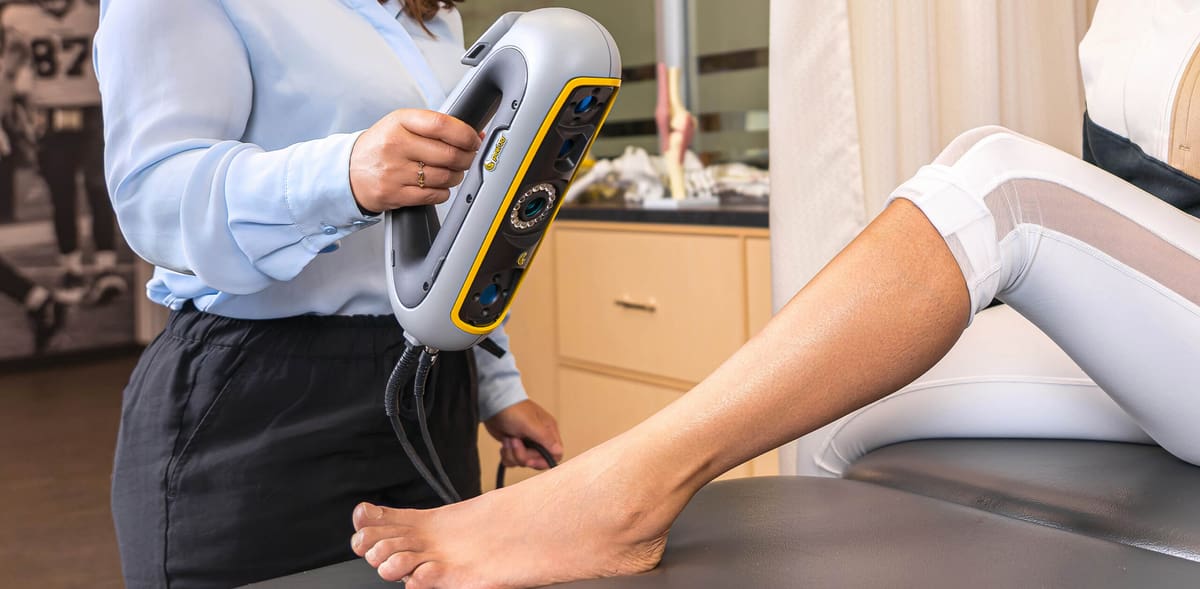
Selecting the most suitable 3D scanner is no simple task. There’s a lot to keep in mind, but the main points to consider are:
- What you will scan? Size, shape.
- Where you will scan? Inside, outside.
One 3D scanner may be the best for small stationary objects, like jewley, but may prove unsuitable for scanning people’s faces. With many scanners, there’s a trade-off between fine detail and speed, although some have settings for both.
A game developer simply creating game assets will be interested in not just a high-resolution mesh but also the texture of the object, whereas a manufacturer may be more interested in the exact measurements of the object.
Before starting, you should also decide where you want to 3D scan your objects and whether you’ll need a handheld scanner.
Another factor to keep in mind while buying the best 3D scanner is the surface of your object. Both laser triangulation and structured-light 3D scanners can have problems with reflective and transparent surfaces, resulting in distorted and fragmented meshes. There are techniques to overcome these issues, but they can require extra steps and materials.
Also consider the minimum computing hardware requirements of the software that comes with the scanner, along with compatibility with your CAD and slicer software.
Peel 3D Peel 3
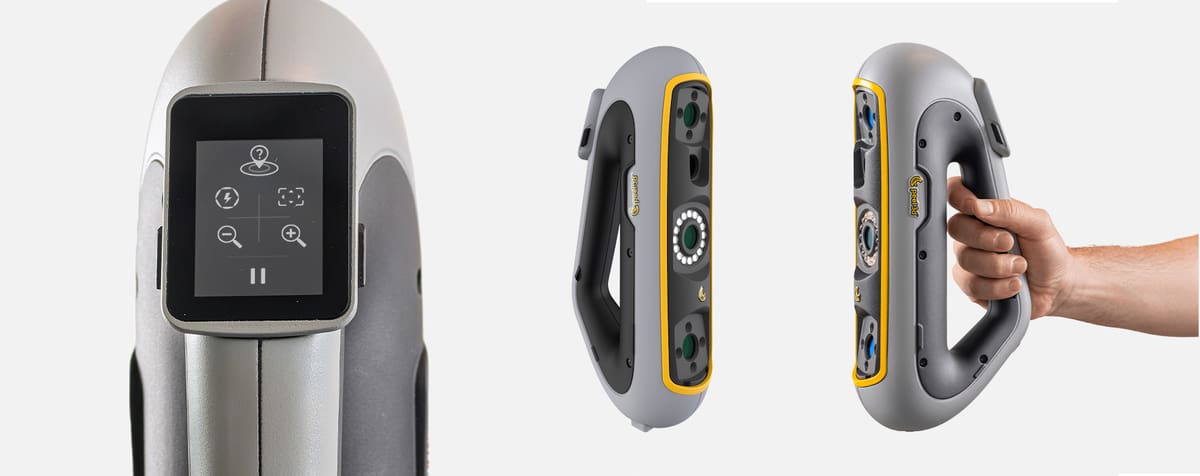
Peel 3D, the Creaform subsidiary that has brought us the Peel 1, 2, and 2-S, has just released the wholly redesigned Peel 3. This scanner boasts not only better accuracy than its predecessors but also focuses on improving usability through an ergonomic design, haptic feedback, and intuitive touchscreen capability.
All these improvements aim to improve the scanning process for newbies and experienced veterans alike to achieve crisp, accurate scans.
The scanner is also offered bundled with proprietary Peel CAD software as the Peel 3.CAD version, which was explicitly designed as a turnkey solution for reverse engineering applications. Peel 3.CAD supports exporting into industry-standard CAD programs like Solidworks, Fusion 360, or Solid Edge. The Peel 3.CAD is currently offered at an introductory price of $11,990 while the standard Peel 3 will currently set you back $8,490 and is shipped within 3 to 5 weeks.
Although Peel no longer offers the scanner’s predecessors on their website, third-party resellers still have them in stock and it might be worth looking into price developments for these machines over the next months. We also have some hands-on reviews of these models for further reading.

Polyga H3
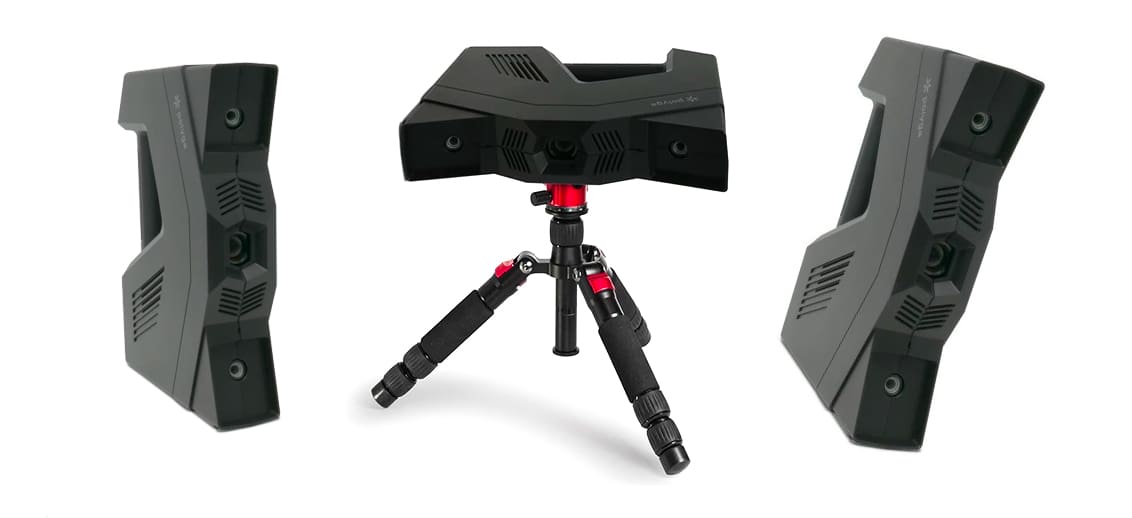
Polyga H3, released in 2020, is an all-round professional handheld 3D scanner that’s easy to use, portable, and boasts high-accuracy. It has a menacing, weapon-like design that may appeal to some, but that aside, it’s a feature-rich and flexible machine.
The H3 is a point and shoot system, like most on this list. Simply move around the physical object to capture it into digital form. It’s powered by dual industrial-grade cameras operating at a speed of 700 frames per second (or up to 1.5 million points per second), the H3 captures objects into complete digital 3D models in minutes. Scan a variety of objects from artifacts, mechanical parts, faces, and even the entire body for work applications in industries including manufacturing, arts, archaeology, medical, computer vision, research, and design.
The H3 can also be mounted on a tripod as a stationary 3D scanner for use with a rotary table.
You have the option to scan in gray scale or color, which is valuable for applications where accurate color and texture information is important.
FARO Freestyle 2

Among the scanners and coordinate measuring machines (CMM) from US-based FARO, the Freestyle 2 is the most versatile. Capable of documenting everything from crimes scenes to construction sites, this handheld scanner captures photorealistic 3D reality with a range of 0.4 to 5 meters.
A favorite among surveyors, architects, and investigators, the lightweight Freestyle 2 offers a real-time display for on-site review and works well in nearly any level of lighting.
Couple this scanner with FARO’s Zone 3D software to create accurate analysis of an event and produce detailed visuals, such as precise 2D and 3D diagrams, animations, and courtroom-ready reports. FARO Zone 3D Advanced, the most recent update, can import point cloud data from laser scanners and drones.
Shining 3D EinScan HX
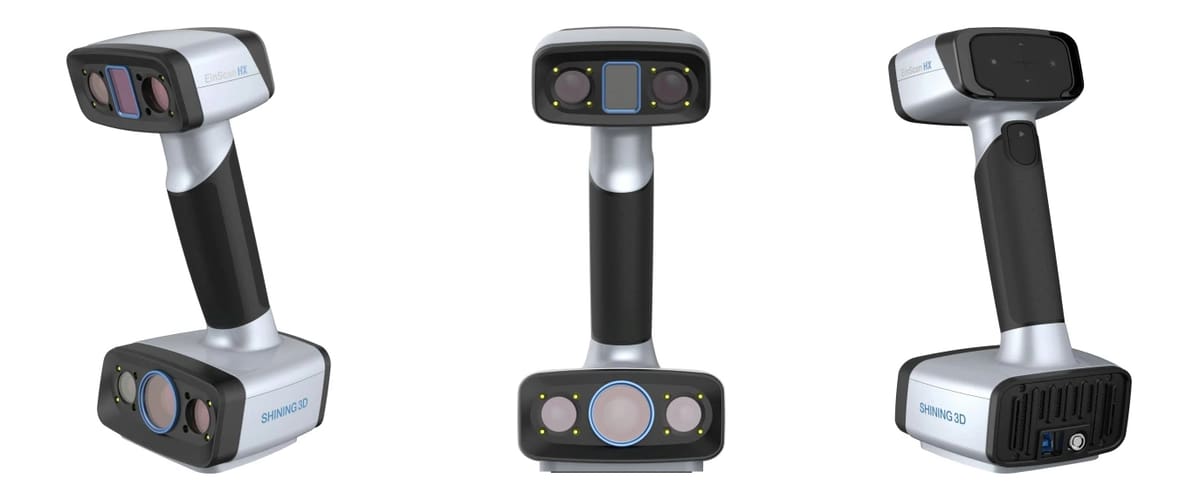
The hybrid blue laser and LED light sources make EinScan HX from Shining 3D compatible with a broader range of object sizes, meeting multiple needs in one unit. It’s also has a built-in color camera to support full-color texture capturing and tracking.
Shining says the LED light scanning allows rapid 3D scanning, while laser scanning, which is less sensitive to ambient light, gives better performance on reflective and dark-color surfaces.
The processing speed of EinScan HX under Rapid Scan Mode is up to 1,200,000 points/sec, and multiple blue laser lines under Laser Scan Mode make scanning of most objects in minutes for reverse engineering, CAD/CAM, 3D printing and etc.
EinScan HX is plug-and-play with user-friendly software. Its ergonomic design lends itself to more efficient and comfortable scanning over tiem.

Artec Eva
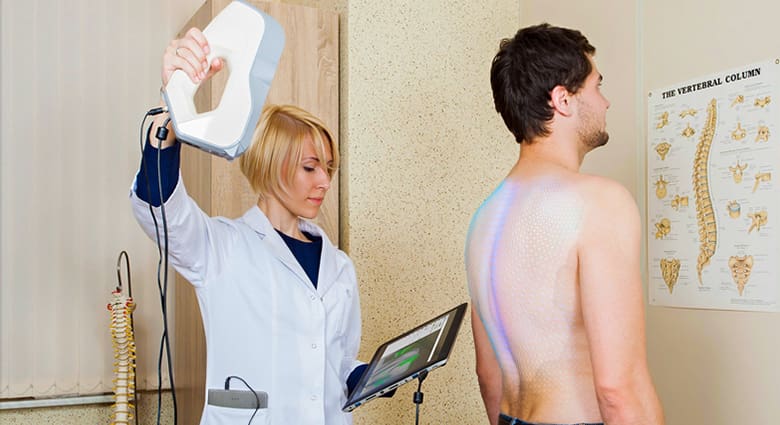
The Artec Eva is considered by many to be the best in class handheld 3D scanner. It is used in just about any field of work imaginable from the aerospace industry to orthopedics.
The Artec Eva is particularly suited to medium-sized objects (including busts), capturing accurate full-color scans quickly and reliably.
It’s possible to set up more than one Artec 3D scanner to speed up or improve the scanning process – an expensive proposition, but a welcome one to note the versatility of the device.
Utilizing structured light for its scanning method, this makes it particularly safe for scanning people and animals. The Eva requires no calibration or warm-up time and is compatible with tablets to make the whole system easier to lug around.
The in-house editing software is not free, however, and does not ship with the handheld 3D scanner. (Unfortunate, given that the Artec Studio software is far and away the best part of using the Eva). If Artec Studio isn’t for you though, since the data from the 3D scanner can be exported, any third-party 3D editing software should be able to get the job done.


Creaform HandyScan 307 Silver Series
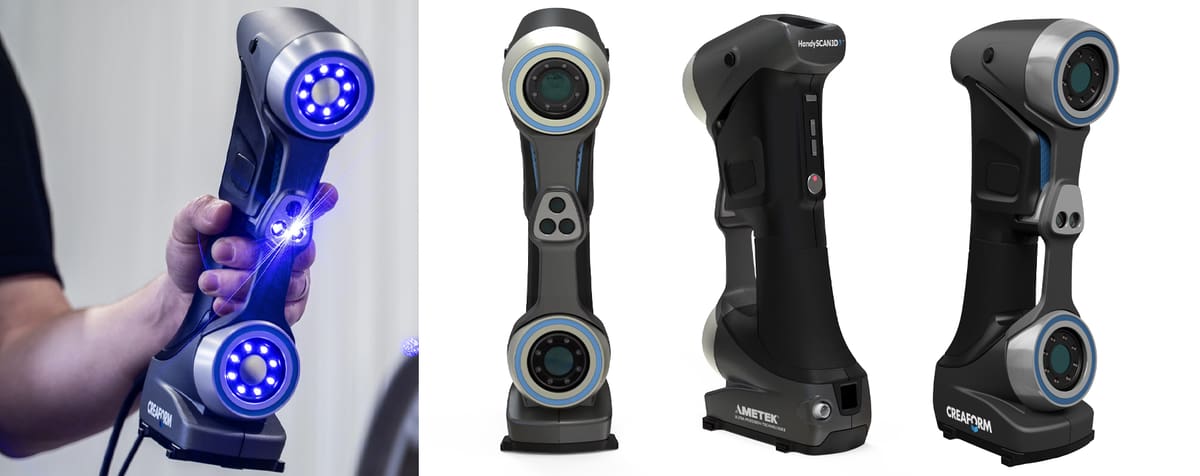
The Silver Series is part of the HandyScan 3D line-up from Creaform, which features patented technology to capture accurate and repeatable 3D measurements of any complex surface in any location.
The HandyScan 307 is optimized for dynamic referencing, which means both the scanner and the part can move freely during scanning and the results will remain highly accurate.
Creaform makes a range of scanners but says this is its most user-friendly with a very short learning curve regardless of the user’s experience or expertise level. Its versatility enables users to scan various objects no matter the part size, complexity, material, or color – all with the same device.
The scanner’s plug-and-play technology makes it compatible with a host of software solutions from Autodesk to 3D Systems.
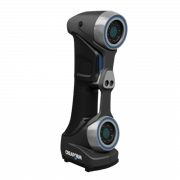

Artec Space Spider
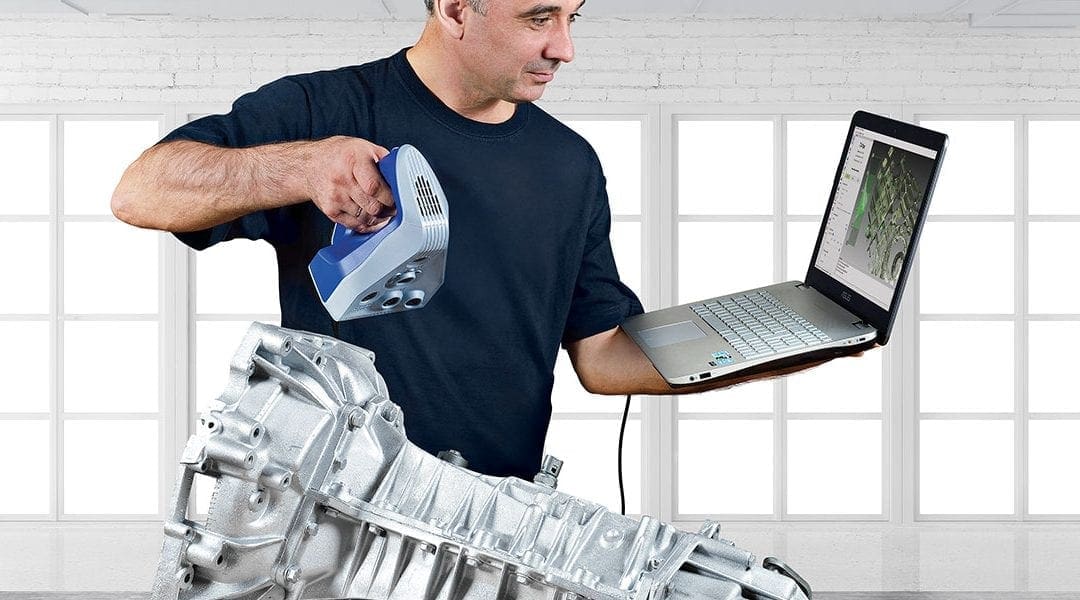
On the higher end of the 3D scanning spectrum is the Artec Space Spider, a high-resolution 3D scanner that uses blue light technology to capture anything from small, intricate objects to large parts in high resolution. Priced below $25,000, the Space Spider is an industrial system that generates 3D models with premier accuracy and vibrant color.
As an advanced version of the original Artec Spider, this is an industrial-grade scanner designed for experienced CAD users who require high precision for applications like reverse engineering, additive manufacturing, quality control, and mass production. It’s able to conquer those pesky features that other scanners can’t handle, such as sharp edges and thin ribs.
What makes it special is that it offers the quality of high-end, mounted scanners while itself being a handheld device.
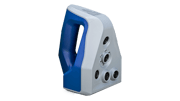

Scantech Simscan
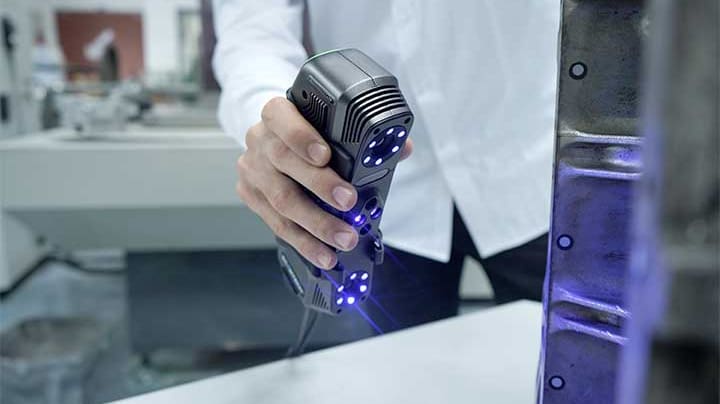
Simscan, from manufacturer Scantech, is the only scanner on our list that could possibly be called pocket size. The one-hand, portable 3D scanner weighs only 570 grams and features a metrology-grade measurement system to capture every detail and construct 3D models quickly.
Simscan provides high-quality scans thanks to a high frame rate and fast data capture. Its remarkably small size enables 3D measurements even in difficult-to-access areas such as engine compartments. The heat-dissipating aluminum alloy housing is enclosed by an ergonomic non-slip shell that doubles as a handle. ScanTech won the 2021 Red Dot Design award for the Simscan’s innovative design.
Scantech produces a range of scanners tuned for various applications that all use the company’s ScanTech 3D software. During scanning, the 3D software gives real-time feedback and seamlessly integrates into the product redesign process.
Artec Leo 2022
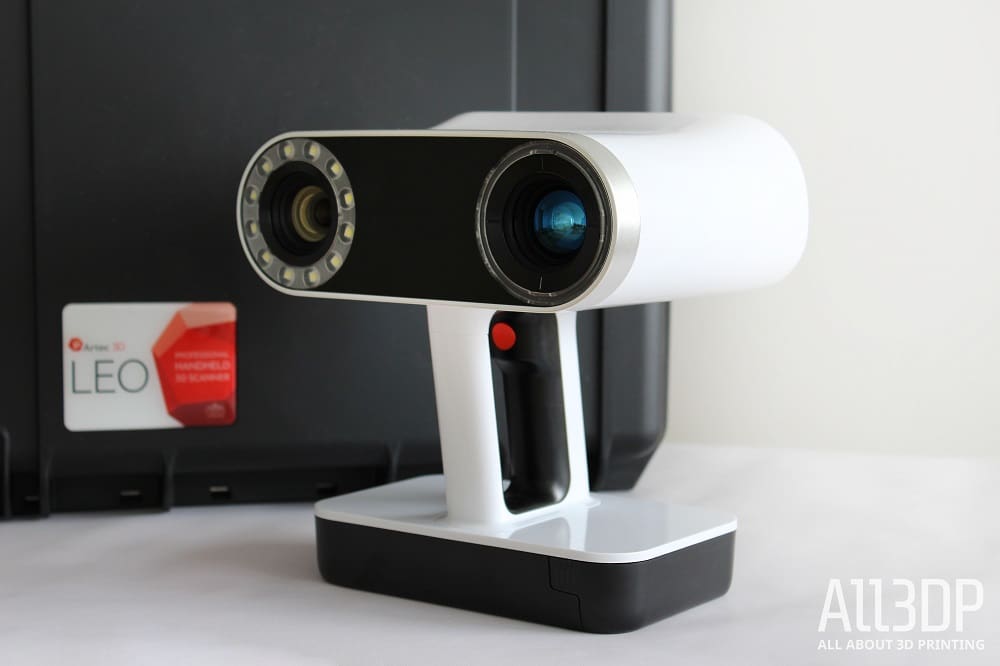
So named because it is the king of the jungle in 3D scanning right now (we presume – could just be a fun coincidence), the Artec Leo is a step-change in the 3D scanning market, offering scan resolution of a magnitude greater than the company’s already market-leading Eva scanner, while adding complete wireless functionality and onboard processing.
A new version dropped in Feb. 2022 that features a new NVIDIA Jetson TX2 chip, which runs at more than twice the power of its predecessor, while using less than 7.5 watts of power to give you better accuracy, the company says. In fact, the 2022 Leo boasts 30% faster graphics processing, twice the onboard storage, and double the RAM specs.
With onboard automatic processing and wireless connectivity, Artec Leo easily captures the widest range of sizes as you move around easily as if filming a video, while a 3D replica is built in real time on HD display.
The Artec Leo effectively removes the laptop or computer from the equation, allowing complete scanning freedom with no wires tethering the user to a workstation. We found scanning with the Artec Leo can be best described as freeing. If you’ve ever used a 3D scanner before and are familiar with navigating the jumble of wires and balancing act of keeping an eye on your tablet or laptop while avoiding tripping around the object, using a Leo will feel like cheating.
The Leo is a fascinating high-end 3D scanner that is well-suited for applications from reverse engineering, industrial design, and automotive to VR/AR, heritage preservation, and scientific research.
To make Leo more accessible to professionals around the globe, 2022 Artec Leo’s interface is available in six languages: English, Chinese, French, German, Japanese, and Spanish.
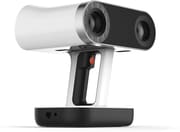

Creaform Go!Scan Spark
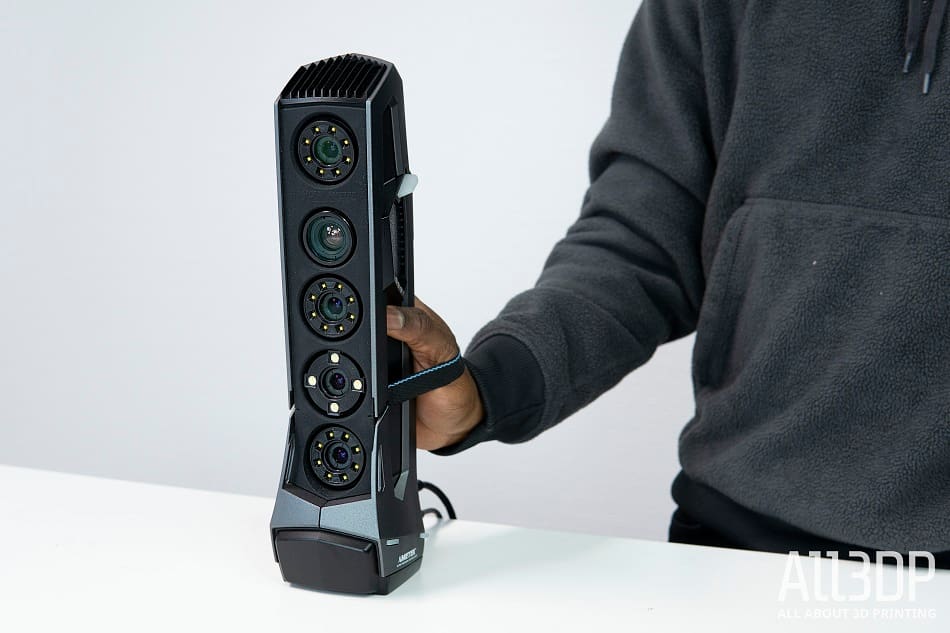
In many ways the most impressive (and expensive) scanner on this list is the Creaform Go!Scan Spark, which was built to replace the Go!Scan 50 and Go!Scan 20 and was completely redesigned in 2019.
We found that this white-light 3D scanner packs a lot of power into a portable package. It outputs professional-grade geometries and textures and takes 1.5 million measurements per second, plus it allows for free movement of both the object and the scanner.
Accurate up to 0.05 mm with a resolution of 0.1 mm, the system uses hybrid positioning to allow for simple and convenient handheld scanning of larger objects, with a workflow that could be considered point-and-shoot.
The accompanying VXelements software boasts a number of optimization features to clean up scans, including automatic hole filling, improved facet capture, and the clean rendering of ribs (useful for mechanical/structural parts). You can also purchase VXmodel separately, which allows for direct CAD integration of your scans.
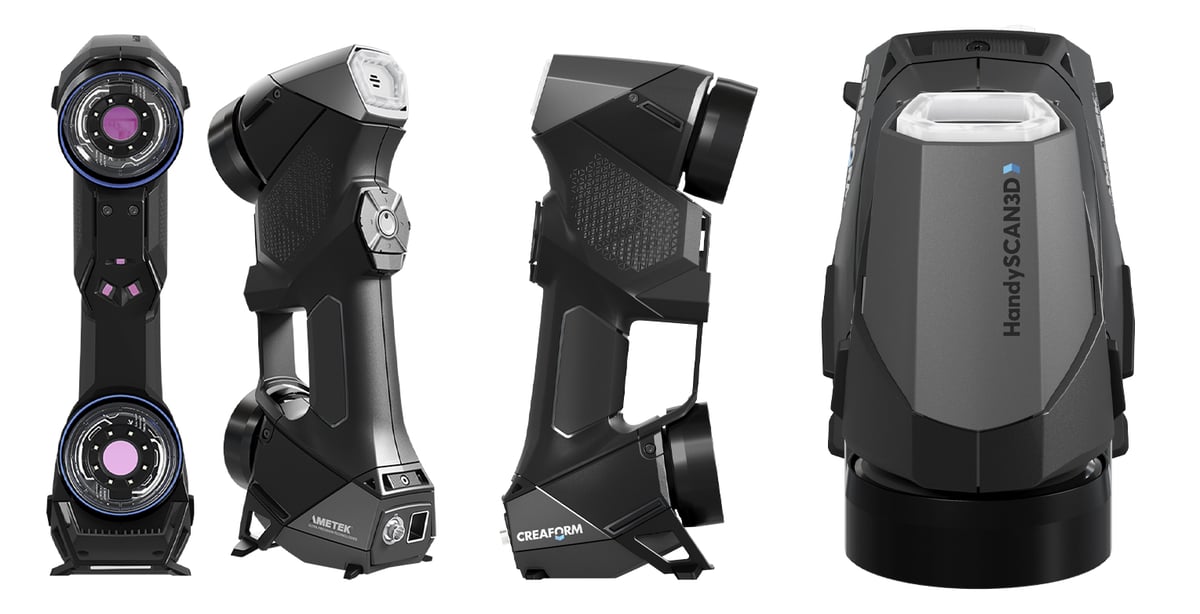
Creaform HandySCcan Black Elite Limited
Just released in 2023, the HandyScan Black Elite Limited from Creaform takes accuracy up a notch to 12 microns (0.012 mm).
Developed over the last decade by optimizing manufacturing and calibration processes, this new milestone in accuracy from Creaform is designed to address the needs in the industrial and manufacturing sectors for high tolerances.
The latest HandyScan features 11 blue laser crosses for an increased scanning speed on difficult surfaces.
The HandyScan Black Elite Limited will be available for delivery starting March 1, 2023.
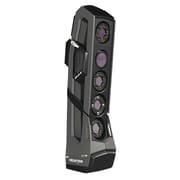

Zeiss T-Scan Hawk 2
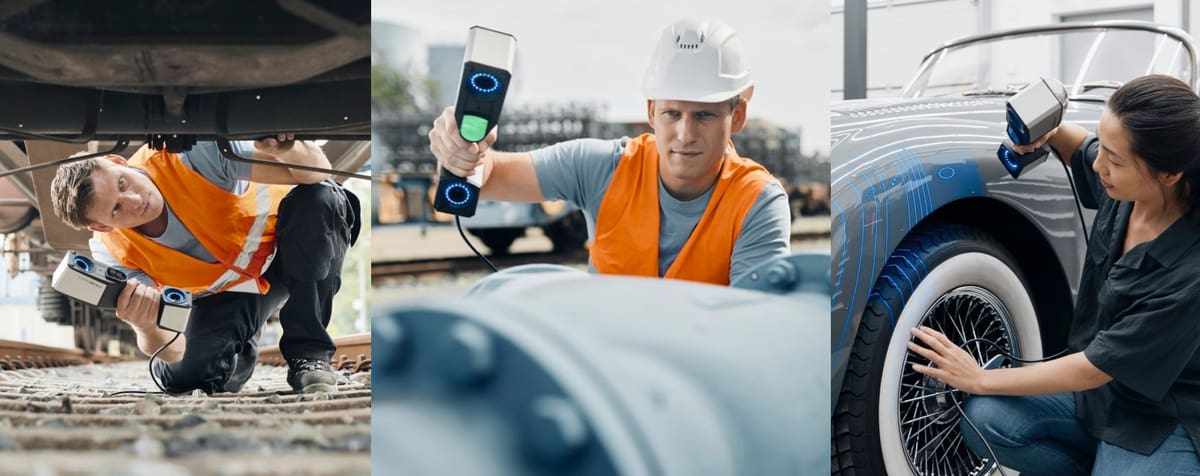
The upgraded T-Scan Hawk 2, released in 2023, from scanning and optic giant Zeiss features three separate laser sources and scanning modes, including red and blue lasers. V.2 introduces the satellite mode that enables users to scan objects up to several meters.
The Hawk can scan ultra-fine details and dark/reflective surfaces as well as large-sized objects.
In the new projection mode, a red laser marker helps you to adjust easily for perfect scanning results. The red scanning lasers are ideal for scanning large objects fast. One single red laser is used for scanning deep inside pockets. Blue lasers on the other hand, are for closer objects and scanning fine detail in higher resolution.
T-Scan Hawk 2 features four buttons to start and navigate your workflow directly on the unit so there’s no need to operate the software separately on your laptop.
This lightweight and compact scanner comes with GOM Inspect Suite software pre-installed. The all-in-one, platform-independent software solution enables you to import 3D data regardless of the measuring system. It supports your entire workflow, from 3D printing and reverse engineering to inspection, evaluation, and reporting.
Laser Triangulation vs. Structured Light in 3D Scanning Tech
The choice between laser triangulation and structured light technology in a 3D scanner depends on your specific requirements, such as the object’s size, material properties, desired accuracy, and your budget. Both technologies have their strengths and weaknesses, making them suitable for different uses.
If you want to freshen up your 3D scanner knowledge or discover the differences between the two most commonly used techniques, here is a quick overview of laser triangulation and structured light.
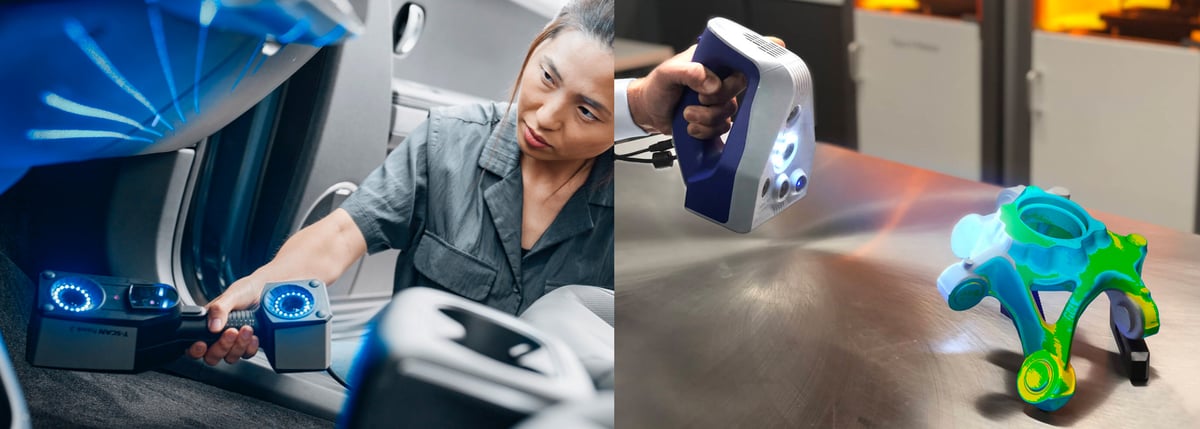
Laser Triangulation
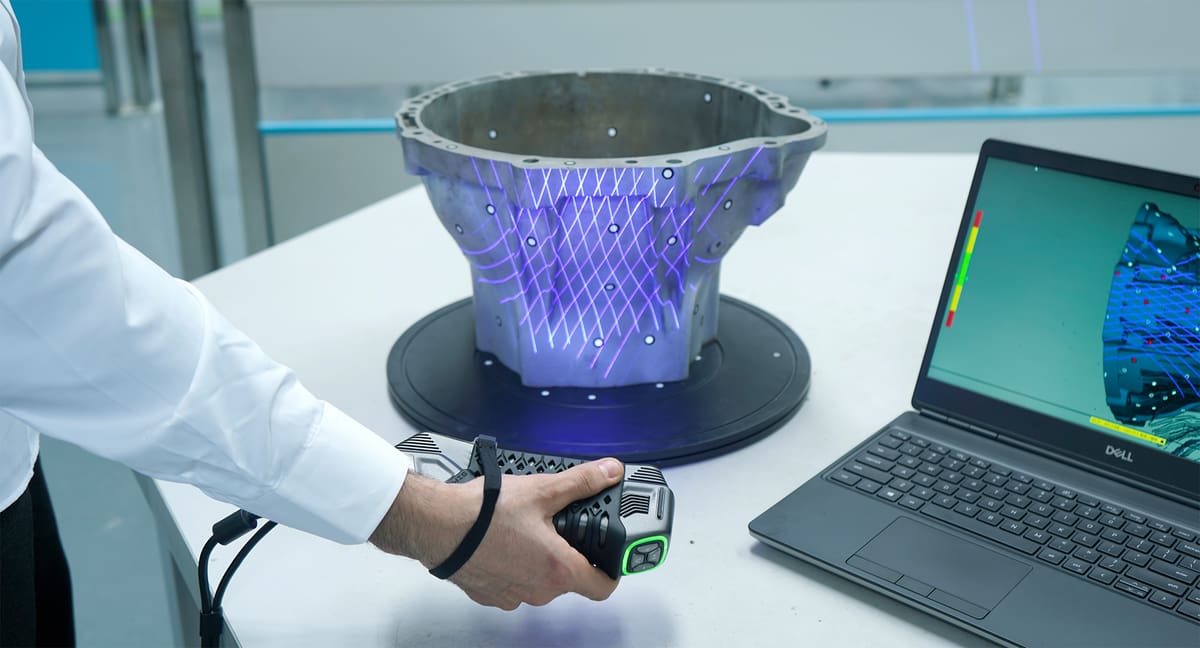
Several scanners on our list use laser-based scanning technology, specifically laser triangulation. Laser scanners project millions of points or lines on an object and then capture its reflection with sensors. Depending on the scale of the scanning target, this is accomplished in three different ways.
The preferred method for mapping large areas up to 1,000 meters away is time of flight (TOF) scanning, where the time it takes for an impulse to reflect off the scanned object is measured. TOF scanning can also be used for shorter ranges, depending on the specific scanner’s capabilities.
The second technology, phase shift, works similarly, only that instead of the impulse it measures the phase differences between the emitted and reflected signals. This method is most commonly used for large objects at a scanning range from 1 to 50 meters, but can be used for various ranges, including shorter and longer distances.
The last and only technology which is listed in this guide is laser triangulation, as it is most suited for smaller 3D scanning applications. Because the sensors are located at a known distance from the laser’s source, accurate point measurements are gathered by calculating the reflection angle of the laser light. With the knowledge of the distance of the scanner from the object, the scanning hardware can map the object’s surface and record a 3D scan. These 3D scanners are famously accurate; the resolution ranges in the tens of micrometers. On the flip side, their range is limited to only a few meters. Additionally, triangulation 3D scanners emitting a laser line are capable of scanning moving objects. This technology is usually found in portable 3D scanners.
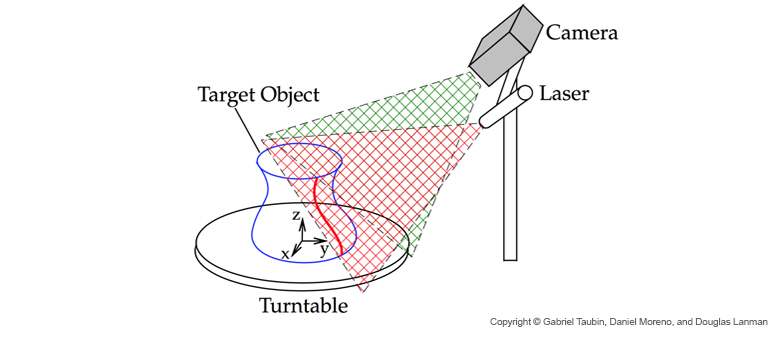
However, you should note that the properties of the surface to scan affect the scanning process. Therefore, very shiny or transparent surfaces can be quite problematic for this technology.
For 3D scanning people and animals, you wouldn’t want to use a 3D laser scanner since it might cause eye damage, especially with pets. Structured light is a better choice. This technology requires the subject to stay relatively.
Structured Light
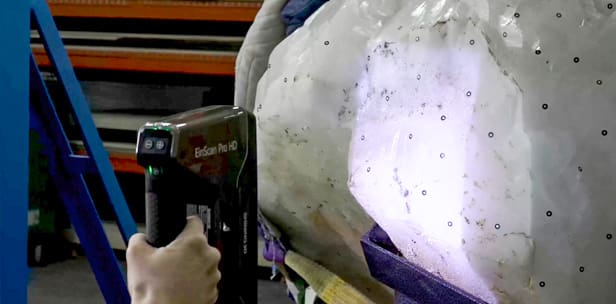
Structured light technology also uses triangulation but works by projecting a light pattern onto the object to scan, not a laser line (or dot).
Since the patterns can only be projected from one vantage point at a time, multiple 3D scans have to be combined to form a complete 360° mesh. Some manufacturers circumvent this constraint by automatically mounting the object on a motorized turntable and stitching the 3D scans together.
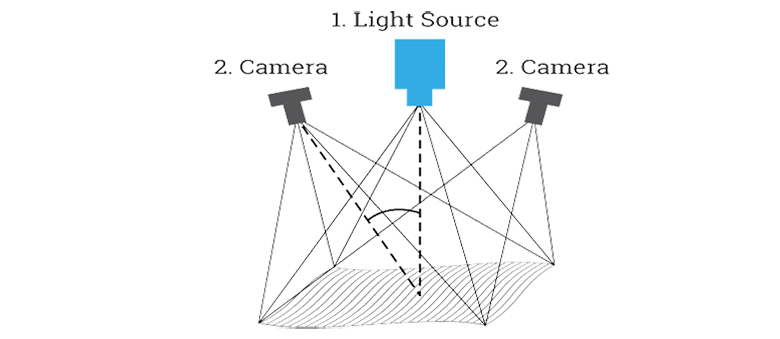
These 3D scanners are very accurate; the resolution ranges in the tens of micrometers. Unlike 3D laser scanners, this technology is safe to apply to humans and animals. The 3D scanning range is limited to a few meters. Structured light technology is found both in stationary and portable 3D scanners.
Most consumer 3D scanners (structured light) are designed for 3D scanning objects the size of your average coffee pot from a close range. But it’s true that you can often stitch multiple 3D scans together into one piece. Generally speaking, the bigger your objects are or the farther away, the more expensive a 3D laser scanner will be.
Accessories for Better Scanning
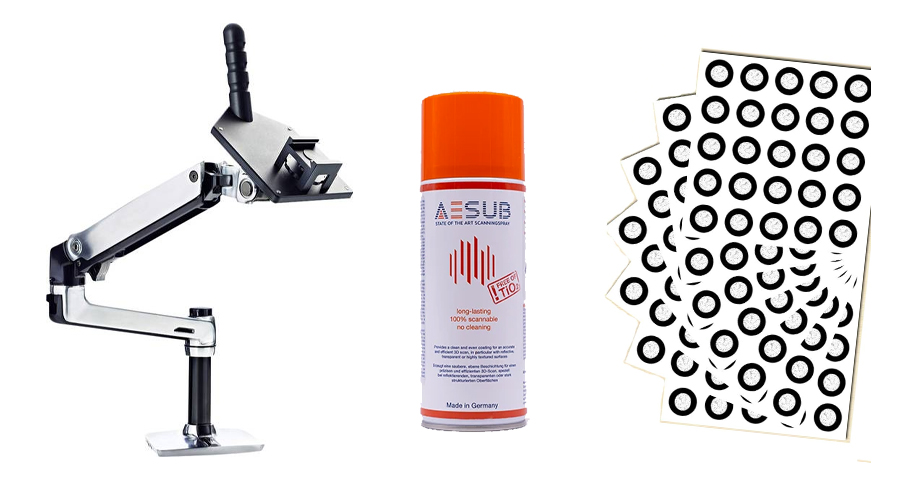
To facilitate the best scans, especially on shiny objects, you may need a scanning spray, which is akin to light spray paint. These sprays are specially formulated for scanning challenging surfaces (reflective, clear, dark, and difficult to reach pitted areas) and coat surfaces with a thin and uniform layer, leaving a clean and smooth matte application. Some varieties completely disappear in a matter of hours.
Even handheld scanners can get heavy after a while, making a scanner lever or track arm particularly convenient. These posable arms enable you to move the scanner into any position while still mounted on a desktop. Going a step further, co-bots or robotic arms can be programmed to scan objects far faster than a human arm.
Target stickers are a useful reference point for handheld laser scanners to improve the accuracy of your scans and measurements. All you need do is apply them in random patterns on the part to be scanned. Your scanning software will use the location of these patterns to determine the target position relative to the scanner and improve accuracy during scanner or target movement.
It’s often easier to rotate your object than move the scanner around it, so motorized turntables come in quite handy. There are many to choose from, and some even sync with your scanning software.
Lead image source: ZEISS T-SCAN hawk
License: The text of "The Best Professional Handheld 3D Scanners" by All3DP Pro is licensed under a Creative Commons Attribution 4.0 International License.
CERTAIN CONTENT THAT APPEARS ON THIS SITE COMES FROM AMAZON. THIS CONTENT IS PROVIDED ‘AS IS’ AND IS SUBJECT TO CHANGE OR REMOVAL AT ANY TIME.




